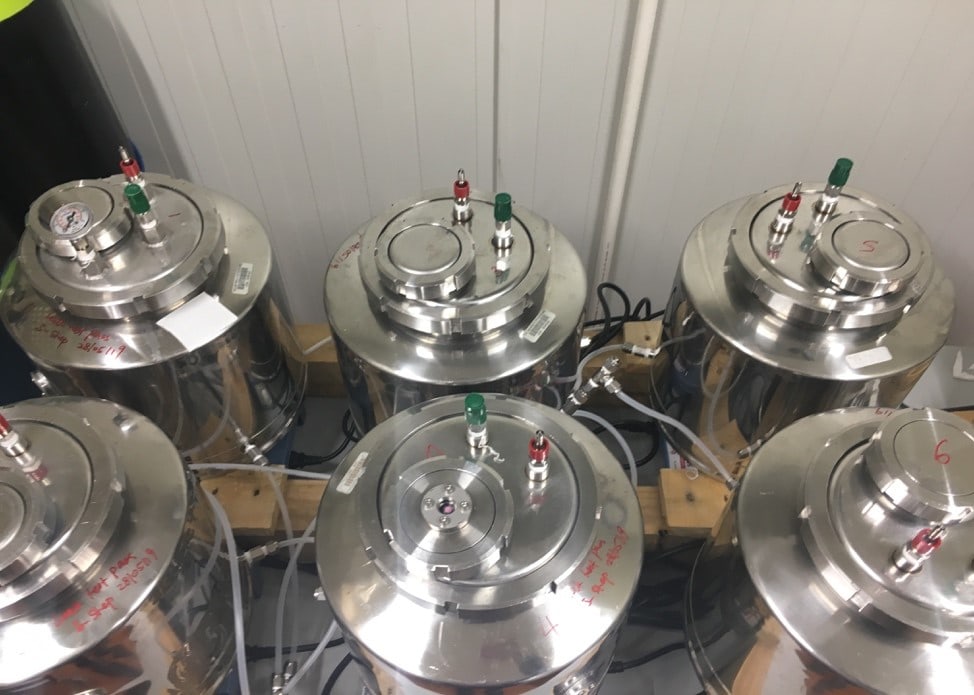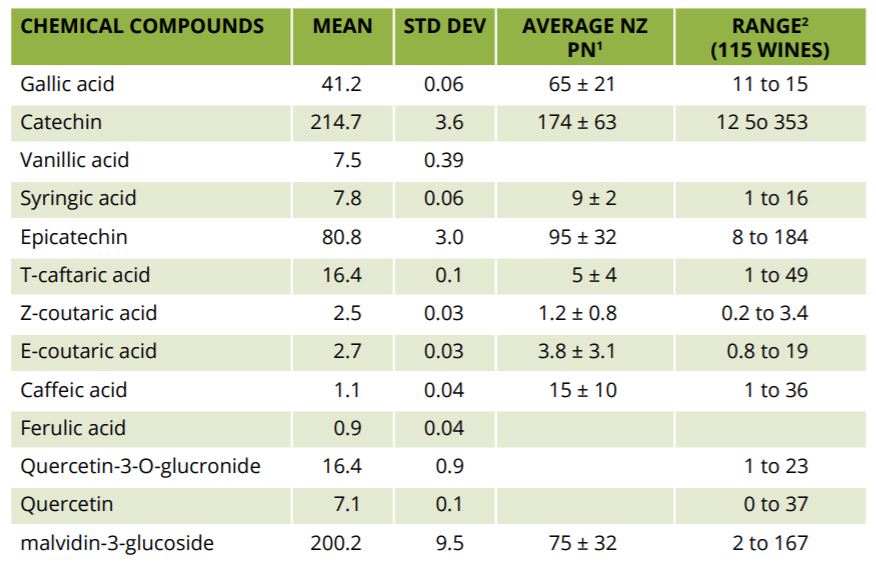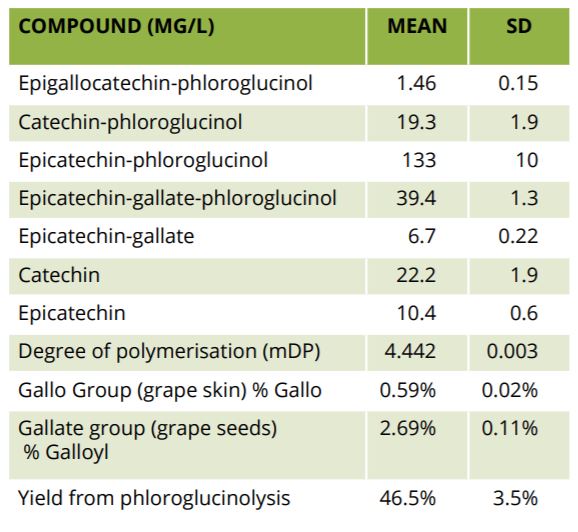Microoxygenation: Understanding the influence of oxygen on the polyphenolic composition of Pinot noir wine and its impact on wine colour and mouthfeel
Article written by Billy Yang, PhD student at the University of Auckland under the supervision of Prof. Paul Kilmartin
The technique of Microoxygenation (MOX) was developed in France at the beginning of the 1990s as an alternative and/or complementary method to barrel aging. Since then it has been applied to red wines all over the world. MOX requires a monitored oxygen micro-supply to diffuse a certain amount of oxygen into wine that is often held in stainless steel tanks. The most important contribution of this technique is the acceleration of oxidation and aging processes in wine. In the literature, MOX, when applied at the desired rates, has been shown to promote polymerisation reactions of polyphenolic compounds in wine (such as anthocyanins and tannins), allowing more stable pigments to be formed. These changes to the anthocyanins present in wines provided more colour than the original pigments.
It is generally accepted that the temperature of wine undergoing MOX should be controlled at around 14-17oC. This is because, a temperature lower than 14oC may result in slow chemical reactions and an accumulation of oxygen, whereas, temperature higher than 17oC may lead to poor oxygen solubility, limiting oxidation reactions in wine. MOX may be applied at any stage during winemaking, although the dosage rate and duration may vary depending on the stage of winemaking, the type of wine, and the desired outcomes. Studies have shown that applying MOX early to wine was much more effective in enhancing wine colour and the formation of more stable pigments.
Therefore, in theory, the application of MOX could be beneficial for Pinot nor wines that are naturally light in colour. This trait of Pinot noir has been well studied, and is related to the low skin to seed tannin ratio and the low pigment content in Pinot noir grapes, as well as other factors, together resulting in the low anthocyanin concentration in the finished wine. However, on the other hand, the lack of phenolics in Pinot noir wines makes it prune to over-oxidation, which could result in wine browning and the development of unpleasant aromas. To date, as the most widely planted red grape variety in New Zealand, Pinot noir wine has a very important place in the New Zealand wine market, and brings significant economic returns to the New Zealand Wine Industry. Thus, understanding the drivers behind Pinot noir wine quality is of importance for New Zealand winegrowers, and microoxygenation may offer an opportunity to develop that understanding.
In order to have a further understanding of the impact of MOX on wine phenolic profile, and at the same time, to determine the desired rates of MOX for improving the sensory characteristics of Pinot noir wines, a MOX trial using a Marlborough Pinot noir wine from the 2019 vintage is being established. Different oxygenation rates and the impact of MOX both pre- and post-malolactic fermentation will be examined in the first MOX trial.

Replicated 15 litre research tanks with polymeric tubing for oxygen supply to Pinot noir wines. Recent additions include small glass windows with NOMASense Oxygen Sensors for monitoring dissolved oxygen content during MOX operations.
The Development of Analytical Methods
In order to quantity the changes of phenolic compounds responding to MOX, accurate and reliable analytical tools and procedures are required. At the University of Auckland, we have successfully established several analytical methods that are being used to analyse wines from within the wider Pinot noir programme. Some of these methods have been in operation at Auckland for red wines studies undertake over the past 20 years, including a High Performance Liquid Chromatography (HPLC) method for quantifying monomeric polyphenols. Further spectral assays are employed for wine colour, and for tannins using the methyl cellulose precipitation assay, first developed in Australia; all students leaving the University of Auckland postgraduate Wine Science programme receive training in these methods. In addition, a series of advanced HPLC procedures have been established locally for the first time, including a method to separate out tannins directly by size, and a “phloroglucinolysis” method that breaks the tannins down into their phenolic units to allow detailed profiling.
Table 1 summarises the range of monomeric phenolic compounds that are quantified using HPLC, for a Pinot noir wine post alcoholic fermentation. The wine has high concentrations of catechin, epicatechin and the anthocyanin malvidin-3-glucoside, typical for Pinot noir wine at the end of fermentation. Comparisons can be made with ranges of values determined in previous surveys of commercial Pinot noir bottled wines wines of various ages (Table 1). Changes in the levels of these compounds will be monitored in the coming MOX trial using this 2019 Marlborough Pinot noir wine.

Table 1. Analytical data obtained from HPLC for monomeric phenolics, in mg/L, for three replicates of a Pinot noir wine post alcoholic fermentation.
Furthermore, in order to verify the changes of polymeric phenolic contents during MOX, we have adapted the phloroglucinolysis method that measures the compositional units of the polymeric tannins. As seen in Table 2, the percentage yield of phloroglucinolysis, at close to 50%, has shown good recoveries, similar to what has been reported in overseas studies. The degree of polymerisation (mDP) represents the average number of constitutive flavanol units, which can vary significantly between skin and seed tannins. As previously reported, skin tannins consist on average of 3 to 83 (mDP), whereas seed tannins are much smaller and have a higher proportion of galloylated units and an average mDP from 2 to 16. In table 2, it can be seen that, the average mDP of the tested Pinot noir wine was about 4.4, which is consistent with a low skin to seed tannin ratio, typical of the Pinot noir grape. In addition, the percentage of gallo group, 0.59% (mainly from the grape skin) and the percentage of gallate group, 2.69% (mostly from the grape seeds), also reflect the specific phenolic properties of the Pinot noir grape.
These compounds play a key role in the sensory characteristics of the wine. For instance, the galloyl ring in epicatechin-gallate and tannins containing this molecule can bind strongly to the proline ring of the salivary proline-rich proteins via hydrophobic interactions, thus resulting in precipitation, which may be perceived as wine astringency. Also, it was previously found that astringency increases with an increasing percentage of galloylation due to the ability of such groups to complex with proteins and peptides. On the other hand, it has been reported that the association between mDP and astringency could be restrained by the presence of epigallocatechin (found the gallo group), so that wine with higher epigallocatechin might provide a softer taste. It will be very interesting to see the changes of these chemical compounds during MOX, which might affect the taste of the wine.

Table 2. Analytical data obtained from the method of phloroglucinolysis for two replicates of a young Pinot noir wine post alcoholic fermentation.
Conclusion and Development of Future Experiments
Wine oxygenation could be a useful tool for improving wine phenolic composition. The changes in the phenolic profile could then affect both the colour and the taste of wine. We will continue to explore this in the future, combing with the use of MOX treatments at controlled rates, to determine the most effective microoxygenation rates and the most influential MOX timing for Pinot noir wine, which hopefully could be used to improve Pinot noir wine quality. Newly developed methods such as phloroglucinolysis will be applied to Pinot noir wines coming from wider sensory and viticultural trials from within the Pinot noir programme to provide a greater understanding of the drivers of Pinot noir colour and mouthfeel properties.
This article first appeared in the August/September 2019 issue of New Zealand Winegrower magazine

















